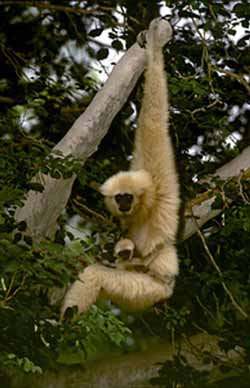White-handed gibbons extinct in China

A scientific team, consisting of members of the Gibbon Conservation Alliance based at Zurich University and the Kunming Institute of Zoology, as well as staff members of the Nangunhe National Nature Reserve, carried out a survey in all Chinese forests reported to support white-handed gibbons (Hylobates lar) during the last 20 years.
The species was last observed in 1988 in the Nangunhe Nature Reserve in south-western Yunnan province, and their loud, melodious calls were last heard in 1992. After two weeks of field work, the 14 member Swiss-Chinese team realized: As a result of continued forest destruction, fragmentation and deterioration, as well as hunting, this gibbon species is no longer part of the Chinese fauna.
«This loss is particularly tragic», says anthropologist Thomas Geissmann, «because the extinct Chinese population was described as a distinct subspecies, the so-called Yunnan white-handed gibbon.» This subspecies (Hylobates lar yunnanensis) is not known from any other place. Geissmann now hopes, that the subspecies may have survived in neighbouring Myanmar, but so far, he has no evidence for this.
«The extinction of the Chinese white-handed gibbons is an urgent alarm signal, because several other ape species in Chinas are also endangered by extinction», says Geissmann. For instance the white-cheeked crested gibbon (Nomascus leucogenys) has not been sighted in China since the 1980s. Of the Cao-Vit crested gibbon (N. nasutus) in the provinces Guangxi (China) and Cao Bang (Vietnam) there are less than 50 individuals, and of the Hainan crested gibbon (N. hainanus) on the South-Chinese island of Hainan less than 20 individuals, to mention just the two most endangered species. Therefore, the scientists warn that the loss of the Yunnan white-handed gibbons may only be the beginning of an unprecedented wave of extinctions which threatens to terminate most, if not all, Chinese ape species.
«We hope that our research results will alarm the Chinese government as well as international conservation agencies and encourage them to initiate immediate efforts to save China’s last surviving apes», says Geissmann.
Media Contact
More Information:
http://www.unicom.uzh.chAll latest news from the category: Ecology, The Environment and Conservation
This complex theme deals primarily with interactions between organisms and the environmental factors that impact them, but to a greater extent between individual inanimate environmental factors.
innovations-report offers informative reports and articles on topics such as climate protection, landscape conservation, ecological systems, wildlife and nature parks and ecosystem efficiency and balance.
Newest articles

Bringing bio-inspired robots to life
Nebraska researcher Eric Markvicka gets NSF CAREER Award to pursue manufacture of novel materials for soft robotics and stretchable electronics. Engineers are increasingly eager to develop robots that mimic the…

Bella moths use poison to attract mates
Scientists are closer to finding out how. Pyrrolizidine alkaloids are as bitter and toxic as they are hard to pronounce. They’re produced by several different types of plants and are…

AI tool creates ‘synthetic’ images of cells
…for enhanced microscopy analysis. Observing individual cells through microscopes can reveal a range of important cell biological phenomena that frequently play a role in human diseases, but the process of…





















